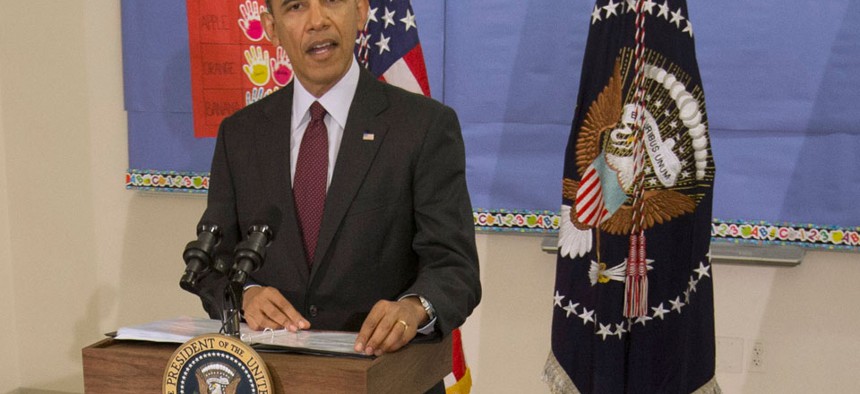
Charles Dharapak/AP
Obama’s Fed-Friendly Budget Blueprint
White House eliminates previously proposed cuts to feds' compensation and plans to announce 1 percent pay raise recommendation next week.
President Obama removed many of the cuts previously aimed at federal employees in his fiscal 2015 budget, instead promising to “unlock the full potential” of the government workforce.
Obama struck a conciliatory tone in the blueprint when referring to federal workers that has been present in the rhetoric of past budgets, but mostly not backed up with substance. The White House on Tuesday announced a new initiative, and corresponding funding, to boost federal employee training and retention.
The budget “invests in the government’s most important resource, its workers, ensuring that we can attract and retain the best talent in the federal workforce and foster a culture of excellence.”
The proposal would fund the Office of Personnel Management to “build a stronger onboarding program” for new members of the Senior Executive Service, as well as leadership and engagement training for new managers to address the “changing needs of a 21st century workforce.” Obama promised his administration will work with labor groups to recruit and retain individuals with “high-demand talents and skills,” and will begin “demonstration projects” in 2015 to identify best practices in hiring, increasing diversity and reducing skill gaps.
In his fiscal 2014 budget, Obama proposed federal employees contribute an additional 1.2 percent of their pay toward their retirement pensions. He also suggested switching to a new formula to calculate inflation, which would result in lower cost-of-living adjustments for federal retirees and Social Security beneficiaries. Both of those measures were eliminated from the current budget, in part due to the recent budget agreement putting in place a pension contribution hike for new employees.
Obama has said the so-called “chained-Consumer Price Index” is still on the table, but the gridlock between congressional Republicans and the White House on deficit reduction has prompted him to eliminate the proposal from his fiscal 2015 budget.
Obama will not formally introduce his 1 percent pay raise proposal for civilian employees until next week, according to White House officials.
The budget was not all good news for federal employees; several agencies would face “right-sizing” under the president’s proposals. The intelligence community would face workforce reductions; the Environmental Protection Agency would “modernize” its workforce, resulting in job “consolidations”; the State Department would look to reduce the number of feds overseas at all agencies; the Transportation Security Administration would save $100 million in 2015 through “staffing efficiencies”; and, as previously announced, the Defense Department will reduce its headquarters funding by 20 percent.
Overall, the Obama budget proposed 136 cuts, consolidations and savings opportunities, which would save $17 billion. For a full list of the budget’s winners and losers, click here.
Obama recommended a series of changes to the Federal Employees Compensation Act that would generate $340 million in savings over 10 years. The proposal -- which is nearly identical to language included in a Senate bill to overhaul the U.S. Postal Service -- would reduce benefits to retirement-age employees receiving workers’ compensation, establish an up-front waiting period before those injured on the job begin receiving payments, and attempt to reduce improper payments. Obama also included the cuts in his fiscal 2014 budget.
The president also retained provisions to reform the Federal Employees Health Benefits Program. The administration wants to give OPM the power to contract with “modern types of health plans rather than being limited to the current four statutorily-defined plans reflective of the 1950s insurance market.” It would also give OPM the authority to negotiate pharmacy benefits for all FEHBP program participants. Currently, health plans participating in FEHBP contract with pharmacy benefits managers, who negotiate with drug manufacturers and pharmacies on behalf of their enrollees. OPM has said that working directly with a single pharmacy benefits manager would reduce costs to beneficiaries. Overall, the administration estimated the changes would save $2 billion over 10 years.
NEXT STORY: A Washington Whodunit: Who Killed Chained CPI?







